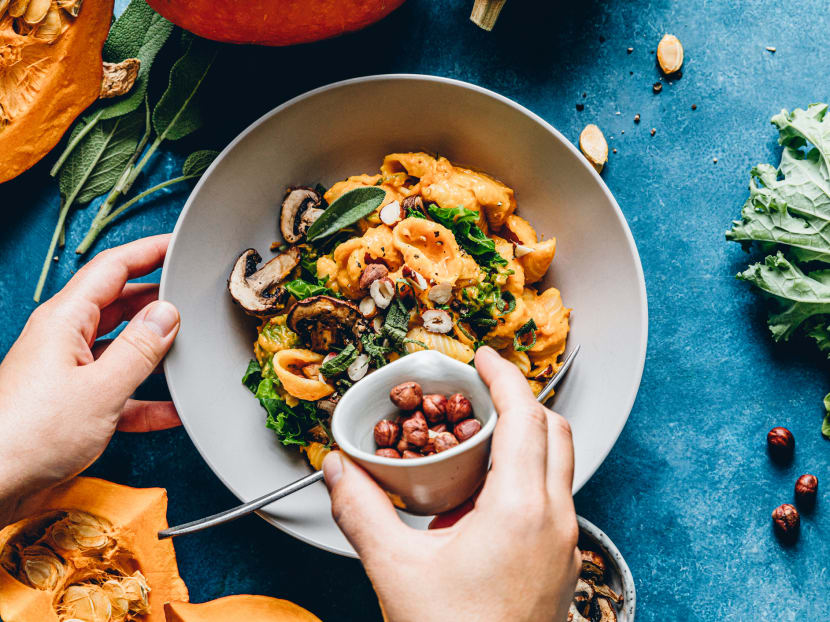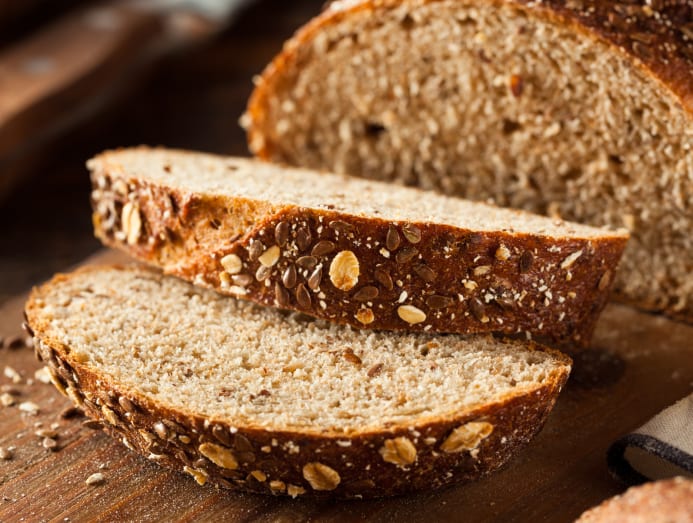Period cramps, pregnancy diabetes, low iron levels: What you should eat and what to avoid
Should you avoid dishes with gravy when you have gestational hypertension? Or drink ginger tea to lessen menstrual cramps? CNA Women asked the experts about how food can help manage certain women-related health issues.

Are you aware of what you're eating? The minerals and nutrients present in your food may help manage current ailments and existing health conditions. (Photo: iStock/alvarez)
When it comes to preventative health, factors such as screening, vaccination and DNA testing come into play. But what you eat – or don’t – also has an important role.
For instance, a friend who developed ovarian cysts was advised by her gynaecologist not to eat pasta and soya beans.
Another friend who has low haemoglobin levels was advised to add beetroot and liver, both high in iron, to her diet.
Meanwhile, a family member who is at risk of heart disease was recommended to adopt a Mediterranean diet that is high in nuts, beans, vegetables and fruits.
So there's some truth to the adage “you are what you eat”. CNA Women finds out how certain foods can help (or hinder) your health.
REDUCING PERIOD PAIN AND PREMENSTRUAL SYNDROME
Drinking a cup of hot tea or eating dark chocolate are both popular remedies for painful menstrual cramps. But is there any truth in them?
Certain foods do contain minerals or vitamins that help you feel less pain. A 2019 clinical paper in South Korea, which studied 200 students aged 18 to 25 years old, found that vitamin D, vitamin E and ginger were useful in reducing the severity of dysmenorrhea (menstrual pain). Ginger had the most significant pain-reducing effect, followed by vitamin D and vitamin E.
Anthea Zee, a dietitian at the Nutrition and Dietetics Department at KK Women’s and Children’s Hospital (KKH), said that you can add ginger into food, drink it as ginger tea or take ginger supplements.
Vitamin D can be found in walnuts, flaxseeds, chia seeds, eggs, and in oily fish such as salmon, mackerel and sardines. Vitamin E is found in wheat germ, dry roasted sunflower seeds, almonds and peanut butter.
A combination of omega-3 fatty acids and vitamin B12 has been shown to have anti-inflammatory properties and found to be more effective in relieving menstrual pain, Zee said. While omega-3 fatty acids can be found in oily fish, walnuts, flaxseeds, chia seeds and eggs, you can find vitamin B12 in dairy products, fortified breakfast cereals and milk alternatives.

Magnesium, too, may provide pain relief for both premenstrual syndrome (PMS) and period pain. “While magnesium helps to relax the smooth muscle of the uterus and reduces prostaglandins (a compound in the body that causes period pain), it also helps to regulate the actions of hormone levels on the central nervous system to reduce PMS,” she explained.
You can find the mineral in dark chocolate, avocado, dark green leafy vegetables, almonds and whole grain products, Zee said.

Additionally, you might want to top up on calcium-rich foods, she said. For example, milk, yoghurt, cheese, fish with edible bones such as canned sardines and anchovies; calcium-fortified soya milk, beancurd and tofu.
“Studies have shown that some of these foods may alleviate the discomfort that comes during both PMS and period pain, although more research studies are still required,” said Zee.
MANAGING LOW HAEMOGLOBIN LEVELS
Women of childbearing age may suffer from iron-deficiency anaemia. Its most common cause, according to healthline.com, is losing iron in the blood when we have our periods.
The other cause is pregnancy, when our bodies need to make more blood to support the unborn baby.
For iron-deficiency anaemia, organ meats such as liver can help replenish your iron stores, Zee said. “Including them in your diet once or twice per week can be beneficial.”
But if your cholesterol level is high or if you are in the first trimester of pregnancy, Zee suggested limiting its intake to two tablespoons per week.
“Organ meats, especially liver, contain high amounts of vitamin A. Excessive intake of vitamin A in the first trimester of pregnancy can lead to birth defects or miscarriage during pregnancy,” she warned.
Alternatively, you can also eat red meat such as lean beef and mutton, two to three times a week.
But you also have to ensure that all the iron you’re eating is absorbed into the body. “Eating dark green leafy vegetables and having fruit after meals increases iron absorption,” she added.
Do remember, however, that there are several causes of low haemoglobin levels, so speak with the doctor to seek the appropriate treatment for it.
EATING WHEN YOU HAVE GESTATIONAL DIABETES
Gestational diabetes refers to a condition where a woman experiences high blood sugar levels during pregnancy.
According to Natalie Yeo, a dietitian at Singapore Heart Foundation, poorly controlled sugar levels may damage blood vessels in the woman’s heart, eyes, kidney and nerves, which may lead to an increased risk of heart disease, kidney failure and others.

Women with gestational diabetes “should be mindful of both the quantity and quality of carbohydrates consumed to improve overall glycemic control”, said Yeo.
That means eating controlled portions and evenly distributing your three meals throughout the day, as well as replacing simple carbohydrates with complex ones, such as wholegrains (think brown rice, quinoa, oatmeal) and root vegetables (sweet potatoes and pumpkin, for example), which are rich in fibre and digested at a slower rate.

Simple carbohydrates such as table sugar, fruit juice and sweetened soda are digested quickly by the body and have the effect of raising blood sugar levels quickly.
However, Yeo said that your calorie requirements and needs during pregnancy should be tailored based on the stage of pregnancy, pre-pregnancy weight, rate of weight gain during pregnancy, activity levels and blood glucose levels.
“Seek a doctor and dietitian’s advice for tailored medical and nutrition intervention to support management of gestational diabetes,” she said.
MANAGING GESTATIONAL HYPERTENSION AND PREECLAMPSIA DURING PREGNANCY
Gestational hypertension refers to high blood pressure that develops during pregnancy after the 20th week. It usually resolves by six weeks after delivery, said Dr Chan Wan Xian, Cardiologist at Asian Heart & Vascular Centre.
Preeclampsia is what happens when a woman has protein in her urine, in addition to gestational hypertension, liver impairment and retention of fluid in the lungs. The condition also impairs heart function and has an increased risk of heart failure during pregnancy.
“Up to 50 per cent of women with gestational hypertension will eventually develop preeclampsia and this progression is more likely when hypertension is diagnosed before 32 weeks of gestation,” she said.
Preeclampsia, too, can affect the baby, restricting the foetus’ growth and development, and increasing the risk of preterm delivery.
Sodium is the culprit here, so in addition to eating a healthy and balanced diet like all pregnant women, you should limit your salt intake, Yeo said. That means eating no more than five grams of salt (or 2,000mg of sodium) a day – that’s less than one teaspoon of salt a day.
Pro tip: When grocery shopping, look at the ingredients list – if the product has sodium or salt listed as the first three ingredients, put it back. You can also look for products with the Healthier Choice Symbol, as these would contain at least 25 per cent less sodium than other similar products.

Avoid processed foods such as those that are canned, salted, smoked, cured, and pickled, as well as pre-packaged foods and snacks such as potato chips and salted nuts. These are all high in sodium.
And remember, gravy- or sauce-laden dishes are also heavy in salt, so avoid them. Of course, it also goes without saying that you should avoid adding extra salt at the table. If you’re cooking, “season your food with natural herbs and spices instead”, said Yeo.
REDUCING THE RISK OF WOMEN’S CANCERS
When it comes to women-related cancers such as breast and endometrial cancer, excess body fat is a factor. Being overweight or obese increases your risk, said Lau Tze Ching, the principal dietitian of Singapore Cancer Society (SCS).
“For cancer survivors, maintaining a healthy weight is important to help reduce the risk of recurrence as well,” she added.
To limit weight gain, the general advice is to avoid foods with little nutritional value, KKH’s Zee said. You know the drill: Foods that are high in sugar and saturated fat, such as cakes, pastries, cream, fatty cuts of meat, fried food, potato chips and sweetened drinks.
RELATED
To reduce your risk of developing breast cancer, avoid or limit alcohol intake. For women who enjoy their tipple, Zee advised that you keep to no more than one drink per day – that means a 330ml can of beer, 100ml of wine, or 30ml of spirit.
Eating carotenoid-rich vegetables such as spinach, tomatoes, carrots, bell peppers, orange, mangoes and watermelon has also been shown to reduce the risk of more aggressive breast tumours, said Lau, adding that although some studies have shown that carotenoids may inhibit breast tumour progression, more research is needed to confirm the link.
Meanwhile, limiting sweetened drinks and sugary foods can help reduce the risk of endometrial cancer. “Women should limit their added sugar to not more than nine teaspoons per day,” said Lau.
CNA Women is a section on CNA Lifestyle that seeks to inform, empower and inspire the modern woman. If you have women-related news, issues and ideas to share with us, email CNAWomen [at] mediacorp.com.sg (CNAWomen[at]mediacorp[dot]com[dot]sg).








